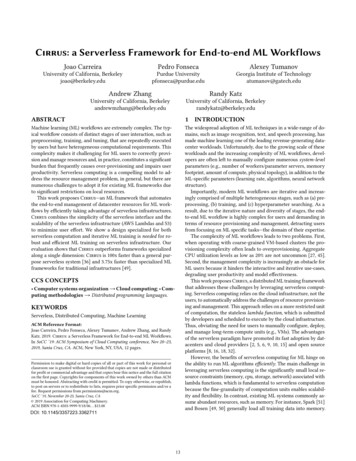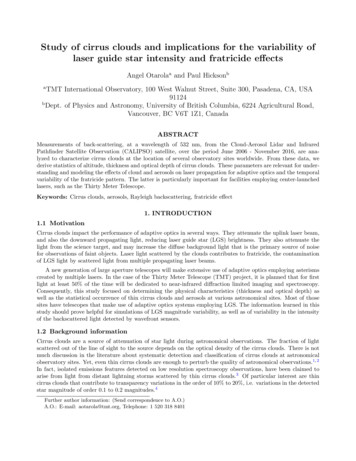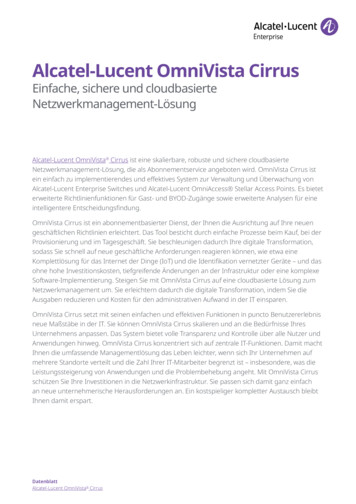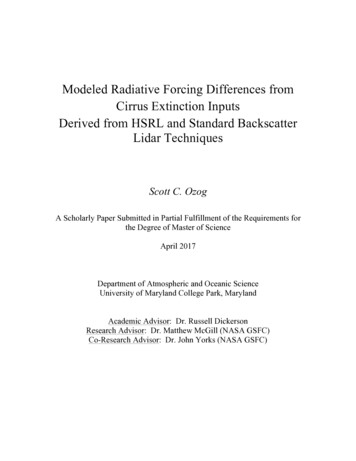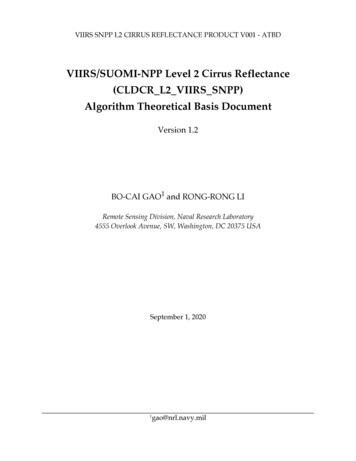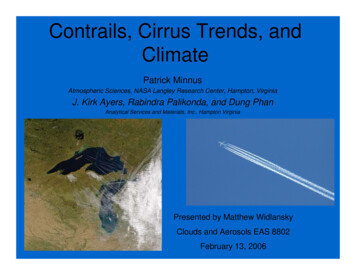
Transcription
Contrails, Cirrus Trends, andClimatePatrick MinnusAtmospheric Sciences, NASA Langley Research Center, Hampton, VirginiaJ. Kirk Ayers, Rabindra Palikonda, and Dung PhanAnalytical Services and Materials, Inc., Hampton VirginiaPresented by Matthew WidlanskyClouds and Aerosols EAS 8802February 13, 2006
Impacts of Contrails and Cirrus Cloudson Radiative Forcing Contrails produced by global air traffic have thepotential to warm the troposphere by trappingout going long wave radiation. Surface observations from 1971 to 1995 show asignificant rise in aerial coverage of contrails andcirrus over the northern oceans and U.S. GCM simulations show that cirrus trends overthe U.S. may have accounted for a .2 -.3 Cdecade-1 local temperature increase.
Contrail and Cirrus formation are dependenton Upper Tropospheric Relative Humidity.Relative humidity probability distribution atflight latitudes with T -50 C Region A- Atmosphere istoo dry for Contrails orCirrus to form. Region BMoist jet engine exhaustcan trigger cloudformation. Region CCirrus formation throughnatural nucleation islikely.
Data Sets Cloud Coverage- Surface-based synoptic weatherreports from land surfaces and ships. (1971-1995)Spreading contrail coverage is taken into account. Relative Humidity- NCEP Reanalysis 300mb annualmean measurements, 2.5 grids. Flight Frequency- 1992 air traffic data is used in theExpected Linear Contrail Coverage (ECON) model. Airtraffic routes are assumed to be “great circle routesbetween two airports”.Questions Is rising air traffic causing a regional or global increasein cirrus and contrail coverage? What climate impact are upper tropospheric cloudshaving?
Major flight paths are generally over regionswhere the relative humidity has remainedthe same or decreased.Major flight paths as indicated bycontrail coverage.Decrease of 300mb RH overWestern Europe between 1971-95.Annual Mean NCEP RH at 300mb
Trends in Cirrus CoverageRegions with more than 15yrs of datadisplayedRegions having trends significant atthe 90% level displayed There have been significant increases in cirrus cloud cover over the U.S. andnorthern oceans. A decrease is observed over Europe and Southeast Asia.
Trends in annual mean 300mb RHRH (300mb) hasdecreased over Europe.RH (300mb) has remainedabout the same over otherland areas.
Correlations of RH (300mb) and CirrusCloud Cover RH trends do notexplain the variationof cirrus over theU.S. and WesternEurope. RH trends explain30-45% of cirruscloud variance overother land areas.
Trends in Cirrus Coverage(broken down by regions)Continental Flight PathRegionsOcean Flight Path Regions There have been significant increases in cirrus cloud cover over the U.S. andnorthern oceans. A decrease is observed over Europe and Southeast Asia.
Seasonal Trends in Cirrus and ContrailsUnited StatesWestern Europe Cirrus and contrail coverage are positively correlated over the U.S. No correlation exists over Western Europe.ISCCP Cirrus trendsECON Expected contrail coverage for 1992.
Climate Effects Global net radiative forcing from air traffic of .006 - .0255W m-2. (1992 values) Immediate response is a warming of the atmospherebelow the contrail or cirrus and a warming (night) andcooling (day) of the land surface. Temperature trends over the U.S. due to air traffic arebetween .16 -.19 C decade-1. Net radiative forcing is expected to increase as globalflight paths become more numerous. Substantial regional climate warming alreadyobserved in areas with heavy air traffic. “Impact may become globally significant” as airtravel continues to grow.
Future Research Improved GCM Simulations– Take into account aerosol concentrations,greenhouse gases, and geographical distribution ofclouds.– Ozone formed from exhaust can cause a troposphericwarming comparable to that from cirrus.– Contrails forming in existing cirrus may increase theoptical depth and affect FNET. Better measurements of upper tropospheric RH, clouddistributions, contrail properties, and flight paths toparameterize GCMs.
References Minnis, P., and Coauthors, 2004: Contrails, Cirrus Trends, and Climate.Bull. Amer. Meteor. Soc., 17, 1671-85.Lohmann, U. and Feichter, J., 2005: Global indirect aerosol effects: areview. Atmos. Chem. Phys. 5, 715-37.
Trends in Cirrus Coverage Regions with more than 15yrs of data displayed Regions having trends significant at the 90% level displayed There have been significant increases in cirrus cloud cover over the U.S. and northern oceans. A decrease is observed over Europe and Southeast Asia.

